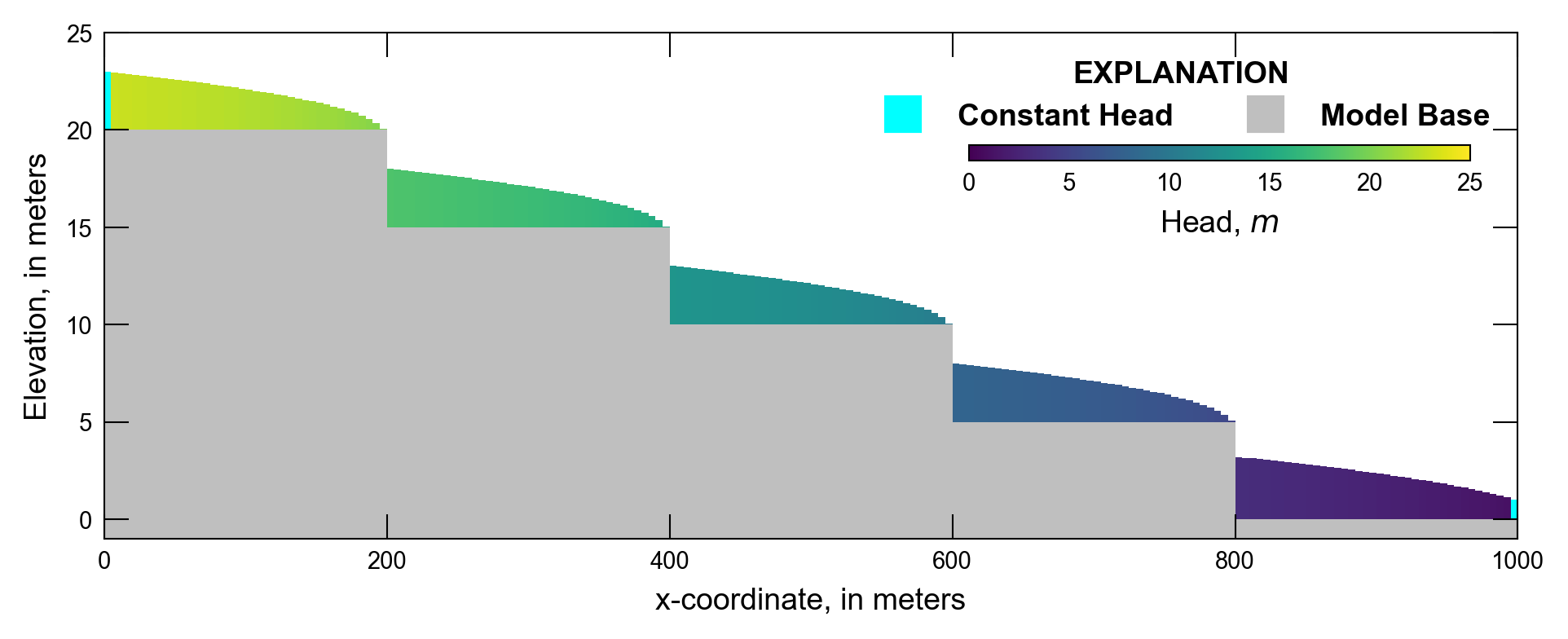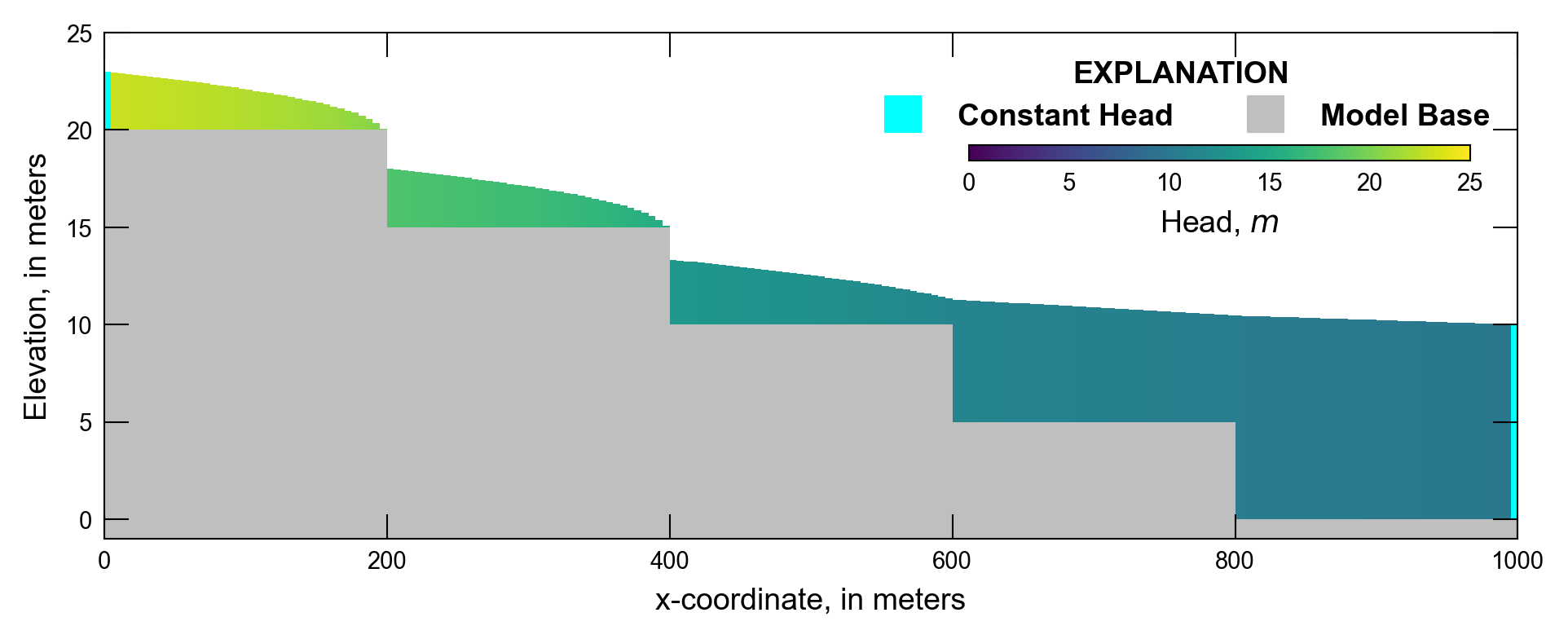This page was generated from
ex-gwf-zaidel.py.
It's also available as a notebook.
Zaidel (2013) example
Described in Zaidel (2013), representing a discontinuous water table configuration over a stairway impervious base.
Initial setup
Import dependencies, define the example name and workspace, and read settings from environment variables.
[1]:
import os
import pathlib as pl
import flopy
import git
import matplotlib.pyplot as plt
import numpy as np
from flopy.plot.styles import styles
from modflow_devtools.misc import get_env, timed
# Example name and workspace paths. If this example is running
# in the git repository, use the folder structure described in
# the README. Otherwise just use the current working directory.
sim_name = "ex-gwf-zaidel"
try:
root = pl.Path(git.Repo(".", search_parent_directories=True).working_dir)
except:
root = None
workspace = root / "examples" if root else pl.Path.cwd()
figs_path = root / "figures" if root else pl.Path.cwd()
# Settings from environment variables
write = get_env("WRITE", True)
run = get_env("RUN", True)
plot = get_env("PLOT", True)
plot_show = get_env("PLOT_SHOW", True)
plot_save = get_env("PLOT_SAVE", True)
Define parameters
Define model units, parameters and other settings.
[2]:
# Model units
length_units = "meters"
time_units = "days"
# Scenario-specific parameters
parameters = {
"ex-gwf-zaidel-p01a": {
"H2": 1.0,
},
"ex-gwf-zaidel-p02a": {
"H2": 10.0,
},
}
# Model parameters
nper = 1 # Number of periods
nlay = 1 # Number of layers
nrow = 1 # Number of rows
ncol = 200 # Number of columns
delr = 5.0 # Column width ($m$)
delc = 1.0 # Row width ($m$)
top = 25.0 # Top of the model ($m$)
strt = 23.0 # Starting head ($m$)
icelltype = 1 # Cell conversion type
k11 = 0.0001 # Horizontal hydraulic conductivity ($m/day$)
H1 = 23.0 # Constant head in column 1 ($m$)
# Time discretization
tdis_ds = ((1.0, 1, 1.0),)
# Build stairway bottom
botm = np.zeros((nlay, nrow, ncol), dtype=float)
base = 20.0
for j in range(ncol):
botm[0, :, j] = base
if j + 1 in (40, 80, 120, 160):
base -= 5
# Solver parameters
nouter = 500
ninner = 50
hclose = 1e-9
rclose = 1e-6
Model setup
Define functions to build models, write input files, and run the simulation.
[3]:
def build_models(H2=1.0):
# Constant head cells are specified on the left and right edge of the model
chd_spd = [
[0, 0, 0, H1],
[0, 0, ncol - 1, H2],
]
sim_ws = os.path.join(workspace, sim_name)
sim = flopy.mf6.MFSimulation(sim_name=sim_name, sim_ws=sim_ws, exe_name="mf6")
flopy.mf6.ModflowTdis(sim, nper=nper, perioddata=tdis_ds, time_units=time_units)
flopy.mf6.ModflowIms(
sim,
linear_acceleration="bicgstab",
outer_maximum=nouter,
outer_dvclose=hclose,
inner_maximum=ninner,
inner_dvclose=hclose,
rcloserecord=f"{rclose} strict",
)
gwf = flopy.mf6.ModflowGwf(sim, modelname=sim_name, newtonoptions="newton")
flopy.mf6.ModflowGwfdis(
gwf,
length_units=length_units,
nlay=nlay,
nrow=nrow,
ncol=ncol,
delr=delr,
delc=delc,
top=top,
botm=botm,
)
flopy.mf6.ModflowGwfnpf(
gwf,
icelltype=icelltype,
k=k11,
)
flopy.mf6.ModflowGwfic(gwf, strt=strt)
flopy.mf6.ModflowGwfchd(gwf, stress_period_data=chd_spd)
head_filerecord = f"{sim_name}.hds"
flopy.mf6.ModflowGwfoc(
gwf,
head_filerecord=head_filerecord,
saverecord=[("HEAD", "ALL")],
)
return sim
def write_models(sim, silent=True):
sim.write_simulation(silent=silent)
@timed
def run_models(sim, silent=True):
success, buff = sim.run_simulation(silent=silent)
assert success, buff
Plotting results
Define functions to plot model results.
[4]:
# Figure properties
figure_size = (6.3, 2.5)
def plot_results(idx, sim, silent=True):
with styles.USGSMap():
gwf = sim.get_model(sim_name)
xedge = gwf.modelgrid.xvertices[0]
zedge = np.array([botm[0, 0, 0]] + botm.flatten().tolist())
# create MODFLOW 6 head object
hobj = gwf.output.head()
# extract heads
head = hobj.get_data()
vmin, vmax = 0, 25
# Create figure for simulation
extents = (0, ncol * delr, -1, 25.0)
fig, ax = plt.subplots(
ncols=1,
nrows=1,
figsize=figure_size,
dpi=300,
constrained_layout=True,
sharey=True,
)
ax.set_xlim(extents[:2])
ax.set_ylim(extents[2:])
fmp = flopy.plot.PlotCrossSection(
model=gwf, ax=ax, extent=extents, line={"row": 0}
)
ax.fill_between(xedge, zedge, y2=-1, color="0.75", step="pre", lw=0.0)
plot_obj = fmp.plot_array(head, head=head, vmin=vmin, vmax=vmax)
fmp.plot_bc("CHD", color="cyan", head=head)
ax.set_xlabel("x-coordinate, in meters")
ax.set_ylabel("Elevation, in meters")
# create legend
ax.plot(
-10000,
-10000,
lw=0,
marker="s",
ms=10,
mfc="cyan",
mec="cyan",
label="Constant Head",
)
ax.plot(
-10000,
-10000,
lw=0,
marker="s",
ms=10,
mfc="0.75",
mec="0.75",
label="Model Base",
)
styles.graph_legend(ax, ncol=2, loc="upper right")
# plot colorbar
cax = plt.axes([0.62, 0.76, 0.325, 0.025])
cbar = plt.colorbar(plot_obj, shrink=0.8, orientation="horizontal", cax=cax)
cbar.ax.tick_params(size=0)
cbar.ax.set_xlabel(r"Head, $m$", fontsize=9)
if plot_show:
plt.show()
if plot_save:
fpth = figs_path / f"{sim_name}-{idx + 1:02d}.png"
fig.savefig(fpth)
Running the example
Define and invoke a function to run the example scenario, then plot results.
[5]:
def scenario(idx, silent=True):
key = list(parameters.keys())[idx]
params = parameters[key].copy()
sim = build_models(**params)
if write:
write_models(sim, silent=silent)
if run:
run_models(sim, silent=silent)
if plot:
plot_results(idx, sim, silent=silent)
Run the Zaidel model with H2 = 1, then plot simulated heads.
[6]:
scenario(0)
<flopy.mf6.data.mfstructure.MFDataItemStructure object at 0x7f327bc77220>
run_models took 32.13 ms

Run the Zaidel model with H2 = 10, then plot simulated heads.
[7]:
scenario(1)
<flopy.mf6.data.mfstructure.MFDataItemStructure object at 0x7f327bc77220>
run_models took 27.19 ms
